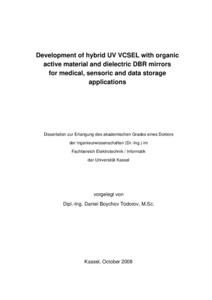| dc.date.accessioned | 2009-10-19T07:26:49Z | |
| dc.date.available | 2009-10-19T07:26:49Z | |
| dc.date.issued | 2009-10-19T07:26:49Z | |
| dc.identifier.uri | urn:nbn:de:hebis:34-2009101930603 | |
| dc.identifier.uri | http://hdl.handle.net/123456789/2009101930603 | |
| dc.description.sponsorship | Otto-Braun Foundation | ger |
| dc.language.iso | eng | |
| dc.rights | Urheberrechtlich geschützt | |
| dc.rights.uri | https://rightsstatements.org/page/InC/1.0/ | |
| dc.subject | ultraviolet | eng |
| dc.subject | Laser technology development | eng |
| dc.subject | Laser fabrication | eng |
| dc.subject | organic active material | eng |
| dc.subject | Vertical-Cavity Surface-Emitting Laser | eng |
| dc.subject | distributed Bragg | eng |
| dc.subject | DBR | eng |
| dc.subject | multilayer structures | eng |
| dc.subject | Laser simulation | eng |
| dc.subject | index coupled VCSEL | eng |
| dc.subject | PECVD | eng |
| dc.subject | DIBS | eng |
| dc.subject | Spiro | eng |
| dc.subject | zirconium dioxide | eng |
| dc.subject | silicon dioxide | eng |
| dc.subject | silicon nitride | eng |
| dc.subject.ddc | 620 | |
| dc.title | Development of hybrid UV VCSEL with organic active material and dielectric DBR mirrors for medical, sensoric and data storage applications | eng |
| dc.type | Dissertation | |
| dcterms.abstract | Lasers play an important role for medical, sensoric and data storage devices. This thesis is focused on design, technology development, fabrication and characterization of hybrid ultraviolet Vertical-Cavity Surface-Emitting Lasers (UV VCSEL) with organic laser-active material and inorganic distributed Bragg reflectors (DBR).
Multilayer structures with different layer thicknesses, refractive indices and absorption coefficients of the inorganic materials were studied using theoretical model calculations. During the simulations the structure parameters such as materials and thicknesses have been varied. This procedure was repeated several times during the design optimization process including also the feedback from technology and characterization. Two types of VCSEL devices were investigated. The first is an index coupled structure consisting of bottom and top DBR dielectric mirrors. In the space in between them is the cavity, which includes active region and defines the spectral gain profile. In this configuration the maximum electrical field is concentrated in the cavity and can destroy the chemical structure of the active material. The second type of laser is a so called complex coupled VCSEL. In this structure the active material is placed not only in the cavity but also in parts of the DBR structure. The simulations show that such a distribution of the active material reduces the required pumping power for reaching lasing threshold. High efficiency is achieved by substituting the dielectric material with high refractive index for the periods closer to the cavity. The inorganic materials for the DBR mirrors have been deposited by Plasma- Enhanced Chemical Vapor Deposition (PECVD) and Dual Ion Beam Sputtering (DIBS) machines. Extended optimizations of the technological processes have been performed. All the processes are carried out in a clean room Class 1 and Class 10000. The optical properties and the thicknesses of the layers are measured in-situ by spectroscopic ellipsometry and spectroscopic reflectometry. The surface roughness is analyzed by atomic force microscopy (AFM) and images of the devices are taken with scanning electron microscope (SEM).
The silicon dioxide (SiO2) and silicon nitride (Si3N4) layers deposited by the PECVD machine show defects of the material structure and have higher absorption in the ultra violet range compared to ion beam deposition (IBD). This results in low reflectivity of the DBR mirrors and also reduces the optical properties of the VCSEL devices. However PECVD has the advantage that the stress in the layers can be tuned and compensated, in contrast to IBD at the moment.
A sputtering machine Ionsys 1000 produced by Roth&Rau company, is used for the deposition of silicon dioxide (SiO2), silicon nitride (Si3N4), aluminum oxide (Al2O3) and zirconium dioxide (ZrO2). The chamber is equipped with main (sputter) and assisted ion sources. The dielectric materials were optimized by introducing additional oxygen and nitrogen into the chamber. DBR mirrors with different material combinations were deposited. The measured optical properties of the fabricated multilayer structures show an excellent agreement with the results of theoretical model calculations. The layers deposited by puttering show high compressive stress.
As an active region a novel organic material with spiro-linked molecules is used. Two different materials have been evaporated by utilizing a dye evaporation machine in the clean room of the department Makromolekulare Chemie und Molekulare Materialien (mmCmm). The Spiro-Octopus-1 organic material has a maximum emission at the wavelength λemission = 395 nm and the Spiro-Pphenal has a maximum emission at the wavelength λemission = 418 nm. Both of them have high refractive index and can be combined with low refractive index materials like silicon dioxide (SiO2).
The sputtering method shows excellent optical quality of the deposited materials and high reflection of the multilayer structures. The bottom DBR mirrors for all VCSEL devices were deposited by the DIBS machine, whereas the top DBR mirror deposited either by PECVD or by combination of PECVD and DIBS. The fabricated VCSEL structures were optically pumped by nitrogen laser at wavelength λpumping = 337 nm. The emission was measured by spectrometer. A radiation of the VCSEL structure at wavelength 392 nm and 420 nm is observed. | eng |
| dcterms.accessRights | open access | |
| dcterms.creator | Todorov, Daniel Boychov | |
| dc.contributor.corporatename | Kassel, Universität, FB 16, Elektrotechnik/Informatik | |
| dc.contributor.referee | Hillmer, Hartmut (Prof. Dr.) | |
| dc.contributor.referee | Salbeck, Josef (Prof. Dr.) | |
| dc.subject.swd | Laser | ger |
| dc.subject.swd | Mehrschichtsystem | ger |
| dc.subject.swd | VCSEL-Laser | ger |
| dc.date.examination | 2009-06-05 | |

